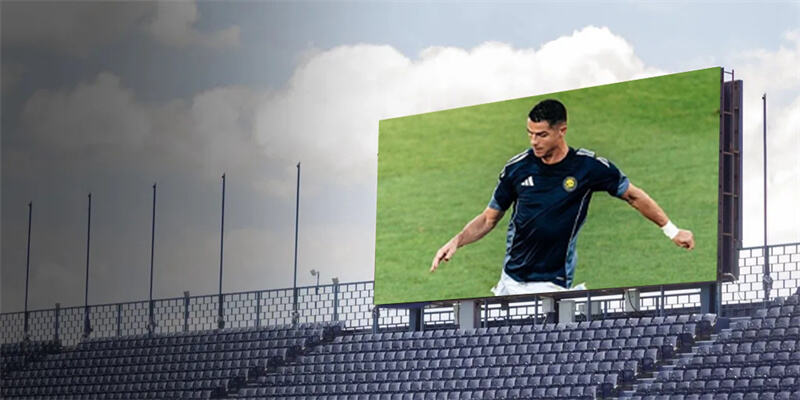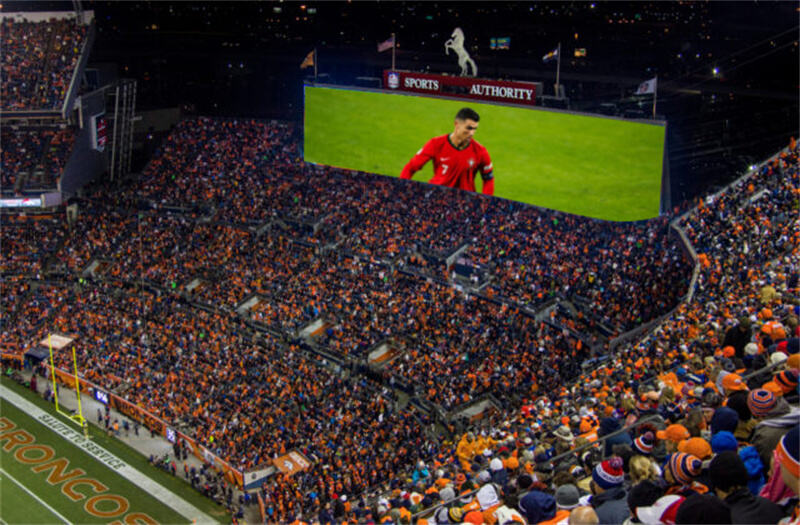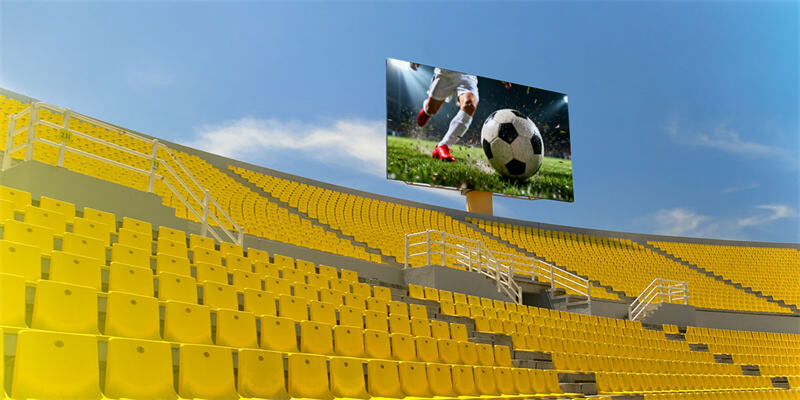Sports Stadium LED Display Solution
In today’s large-venue sports and entertainment venues, installing an LED screen for stadium purposes is no longer optional—it is a strategic asset that enhances fan experience, commercial revenue, and venue branding. Whether you are building a new stadium or upgrading an existing sports arena, a well-designed stadium LED display system plays a critical role in operations, advertising, and audience engagement.
As a professional LED screen manufacturer/solution provider, we will walk through the full solution: from requirements analysis, technical specification, design & installation, content & operations, to maintenance and ROI. The goal is that when you search for LED screen for stadium, you find this comprehensive guide and feel confident in deploying an optimal system.

Why Choose an LED Screen for Stadium Applications
Deploying An LED Screen For Stadium Use Offers Multiple Benefits:
Enhanced Fan Experience: Modern venues rely on high-quality visuals—live action replays, statistics, player intros, crowd cam, and social media integration. LED video walls fulfil this.
Advertising & Commercial Revenue: A large LED screen becomes a premium advertising surface. Dynamic, full-colour video ads bring higher CPM than traditional static banners. Unilumin
Versatility Across Events: Stadiums are used not only for sports, but concerts, shows, corporate events. A flexible LED display system adapts to many event types. reissdisplay
Improved Communication & Brand Display: From way-finding to emergency messaging, LED screens support real-time info display.
Long-Term Value & Efficiency: Modern LED panels are energy efficient, have long lifespans, and robust construction for large venues. Unilumin
Given these advantages, the key is to design correctly to meet stadium-specific demands (brightness, viewing distance, durability, integration, maintenance) — otherwise the investment may underperform.

Key Requirements & Specification for Stadium LED Screen
When planning an LED screen for stadium, dozens of technical parameters matter. Below we summarise the critical ones.
Viewing Distance & Pixel Pitch
Pixel pitch must be matched to the minimum viewing distance. A common rule: H=k×dH = k \times dH=k×d where ddd = viewing distance in m, k≈345 (from design guidance).
For large outdoor stadiums with long viewing distances, you may select P6 mm, P8 mm or even larger. For indoor arenas or VIP zones with closer seats, you may require finer pitch like P2.5 mm or P3 mm.
Example: The “what are the requirements” article states “for outdoor large sports venues, screens with larger pixel pitches like P6 or P8 are commonly considered.”

Brightness, Contrast, and Outdoor Suitability
Outdoor stadiums require high brightness levels (e.g., ≥5,000 nits) to remain visible under direct sunlight. reissdisplay
Contrast ratio should achieve clear image even under daylight. For example, a minimum 100:1 contrast ratio is recommended.
For indoor use, brightness requirements may be lower (e.g., ≥800 cd/m²) but still need good uniformity.

Viewing Angle & Resolution
Stadium displays must deliver adequate viewing angles so that fans seated off‐axis still see clear visuals. Recommended horizontal viewing angle ≥150°, vertical appropriately considered.
High resolution supports crisp video, player close-ups, text and graphics. For large screens, 4K or higher content may be required.
Refresh Rate & Driving ICs
To support live-feed broadcast cameras and to avoid flicker, high refresh rates (≥3840 Hz) are important.
Good driving ICs ensure stable scanning, colour uniformity, and longevity.
Durability, Weatherproofing, Safety & Maintenance
Outdoor stadium LED panels must meet IP65 (or higher) for dust/water ingress.
Modules must be anti-collision (for perimeter boards), flame retardant, robust against impacts and wind loads.
Maintenance access (front or rear) should be planned for efficient operation, module replacement, calibration. LED Screen Factory
Electrical protections: proper power supply, overload/ leakage protection, step-power‐on to reduce inrush, lightning protection, flame retardant materials.
System Integration & Content Management
The LED system should support multiple input types (camera feeds, live stats, graphics, animations). LED Screen Factory
Integration with venue management systems (scoreboard, timer, sound system, broadcast) is essential.
Real-time content switching, scheduling, remote monitoring, cloud control add value.

Layout, Structural & Installation Considerations
Determine usage first: sports vs concerts vs multi‐use event. Each calls for different functional zoning.
Screen layout must ensure 95%+ of seats have unobstructed view. The mounting structure must meet structural load, wind/snow loads, vibration mitigation.
Panel design (modular, bezelless) for seamless imagery.
Sustainability & Energy Efficiency
As venues aim to reduce energy consumption, choosing energy-efficient panels (less power per unit area) is important. Unilumin
Maintenance costs, spare parts availability, and system scalability also influence lifetime cost of ownership.
Solution Framework: Design & Implementation of an LED Screen for Stadium.
Below is a proposed solution framework you can adopt and adapt based on stadium size, budget, and use-case.

Needs Analysis
Define venue: indoor arena or outdoor stadium; seat capacity; viewing distances; main usage (sports, multi-event).
Identify target uses: live game/distance view, replays, perimeter advertising, ribbon boards, fan zones, external façade.
Stakeholder goals: fan engagement, commercial revenue (advertising), branding, operational communication (timers, stats).
Budget and timeline constraints: procurement lead-time, installation windows (off-season), maintenance plans.
Specification Drafting
Based on needs analysis, produce technical spec:
Pixel pitch: e.g., For outdoor large end-zone screen with minimum viewing distance 50 m → P6 or P8.
Brightness: outdoor end-zone target ≥6,000 nits; indoor scoreboard ≥1,200 cd/m².
Refresh rate: ≥4,000 Hz to avoid flicker under broadcast.
Viewing angle: horizontal ≥150°, vertical comfortable for upper deck.
Structure: IP65 outdoor rating; flame-retardant casing; vibration/wind tolerance.
Module dimensions: e.g., 500×500 mm panels, front-serviceable if wall mounted.
Control system: Dual input redundancy, supports live feed, media assets, ticker.
Integration: Interface with scoreboard/timing system, sound system, broadcast system.
Maintenance: Spare modules, remote monitoring, warranty terms.
Energy: Specify power consumption per m², cooling/ventilation needs.
Layout & Installation Design
Identify screen locations: e.g., two large video walls at each end zone, LED ribbon boards around upper deck, perimeter boards for advertising.
Structural design: Collaborate with structural engineer — ensure mount supports weight, wind, seismic loads; access for maintenance; cable routing.
Viewing geometry: Simulate sight lines to ensure clear view for fans in all sections.
Content zones: Partition screen areas for live video, replay, sponsor ad, stats, social media feed.
Installation logistics: Schedule during off-season; coordinate with other trade works; ensure power supply & data network readiness.
Content & Operations
Define content strategy: Live game feed, instant replays, player stats, sponsor ads, fan engagement segments (Kiss Cam, Fan Cam), social media integration.
Content management system (CMS): Capable of scheduling, switching zones, remote updates, supporting multiple input sources.
Advertising workflow: Provide ad templates, content guidelines, slot scheduling & reporting for sponsors.
Operations team: Training for venue staff, control room operators, content producers.
Maintenance plan: Daily check, periodic calibration (brightness/uniformity), module inspections, dust/water ingress checks.
Maintenance & Lifecycle
Set KPIs: uptime ≥99.5%, module replacement time ≤30 minutes, colour uniformity deviation Δx/Δy ≤0.03.
Maintenance features: Hot-swap modules, front access serviceable, remote diagnostics.
Spare parts: Keep critical spares on-site (power supplies, modules, control cards).
Calibration: Yearly or semi-annual colour/balance check, brightness adjustment to maintain target nits.
Software updates: Firmware, CMS patches, remote monitoring alerts.
End-of-life planning: Typical LED lifespan 50,000-100,000 hours (depending on duty cycle).
Content Structure & Depth
Provide a long-form article (~2,000 words) with sub-sections (as above) to satisfy both search engines and users.
Use bullet points, numbered lists, tables for specification comparison.
Include real-world case studies (e.g., mention major stadiums using large LED screens), to build authority.
Use image alt tags and captions comparing different LED stadium display types (scoreboard, perimeter, ribbon).
Internal linking: Link to related pages like “LED screen for outdoor events”, “fine pixel pitch LED wall indoor”, “LED perimeter boards advertising”.
External linking: Reference credible industry blogs or manufacturer white-papers (as we cited above) to build trust.
Example Specifications
Here is a sample specification table for an LED screen for stadium end-zone installation:
| Parameter | Specification |
| Viewing Distance | Min 30 m, Max 120 m |
| Pixel Pitch | P6.0 mm |
| Screen Size | 12 m (W) × 8 m (H) = 96 m² |
| Brightness | ≥ 6,000 nits (daylight readable) |
| Contrast Ratio | ≥ 100:1 |
| Refresh Rate | ≥ 4,000 Hz |
| Viewing Angle | Horizontal ≥150°, Vertical ≥120° |
| IP Rating | IP65 front / IP54 back |
| Module Size | 500 × 500 mm panels |
| Service Access | Front-serviceable |
| Integration | Live feed (HD-SDI/12G), HDMI, DVI, LAN |
| Power Consumption | ≤ 650 W/m² (typical) |
| Life Span | ≥ 50,000 hours |
| Warranty | 3 years |
These numbers are illustrative—they must be adapted for your specific venue context (distance, seating layout, ambient light, budget).
Frequently Asked Questions (FAQ)
Q1: Can we use a standard indoor LED screen for an outdoor stadium?
A1: Generally no. Outdoor stadiums require much higher brightness, weatherproofing, anti-glare, higher protection rating, and structure capable of wind/snow loads. Indoor panels may not suffice. Unilumin
Q2: What pixel pitch should we select?
A2: It depends on the minimum viewing distance. Use the formula H=k×dH = k × dH=k×d. For long distances, you can choose coarser pitch (P6, P8). For close-range VIP areas, finer pitch (P2.5 or P3) may be necessary.
Q3: How long will the LED screen last?
A3: With proper maintenance, many stadium LED screens are rated for 50,000-100,000 hours. But lifespan also depends on duty cycle, environment (temperature/humidity), and maintenance regime. reissdisplay
Q4: What about maintenance and module replacement?
A4: Choose a modular design with front-service access if mounting location is difficult. Have spare modules and power supplies onsite. Implement remote monitoring to detect failures early. LED Screen Factory
Q5: What is the ROI for a stadium LED screen?
A5: Consider incremental advertising revenue, operational savings (lower maintenance/energy vs older boards), improved fan retention and ticket sales. Create a pay-back model based on these inputs.

Why Choose Us As Your LED Screen For Stadium Partner
As a seasoned manufacturer/solution provider specialising in large-scale LED screens and installations, we offer:
Over 500 cases of LED screen delivery including stadiums, arenas and outdoor venues.
Custom design capability: module size, pitch, layout tailor-made for your venue.
Full end-to-end services: consultation, design, manufacture, installation, commissioning, content integration, maintenance.
Integration expertise: with scoreboard systems, broadcast feed, commercial advertising platform.
After-sales and maintenance support: spare parts, remote diagnostics, calibration services.
Proven reliability: high-durability outdoor LED panels, IP65 rated, high refresh driving ICs, modular servicing.